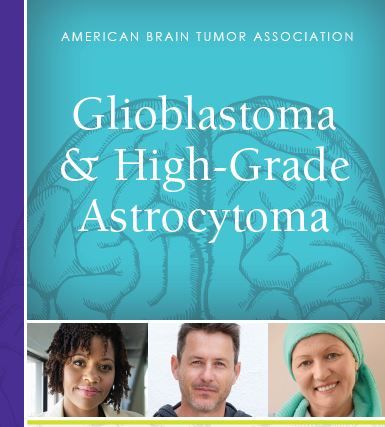Glioblastomas (also called GBM) are malignant (cancerous) grade 4 tumors. The tumor is predominantly made up of abnormal astrocytic cells, but also contains a mix of different cell types (including blood vessels) and areas of dead cells (necrosis). Glioblastomas are diffusely infiltrative and invade nearby regions of the brain. They can also sometimes spread to the opposite side of the brain through connection fibers (corpus callosum) or the ventricular system. It is exceedingly rare for glioblastomas to spread outside of the brain and spinal cord.
In 2021 the World Health Organization (WHO) updated CNS tumor classifications, incorporating new knowledge gained from additional molecular markers and new diagnostic techniques. What used to be classified as Glioblastoma, IDH mutant is now classified as Astrocytoma, IDH mutant, grade 4. For information on Astrocytoma, IDH mutant, grade 4, please see our web page on Astrocytoma (Adult type). Glioblastomas are now classified as Astrocytoma IDH-wildtype tumors with at least one of the following: microvascular proliferation, necrosis, EGFR amplification, TERT promoter mutation, or combined gain of chromosome 7/loss of chromosome 10 copy number changes.
Have you or a loved one been diagnosed with Glioblastoma? Start here.
We’ve put together a few first steps to help you navigate a GBM diagnosis. This free educational booklet has what you need to make sense of your diagnosis and treatment, and tips for moving forward on your glioblastoma journey.
Location
Glioblastoma is most commonly found in the frontal lobe, followed by the temporal, parietal, and occipital lobes. It is found less commonly in the cerebellum.
Symptoms
Patients with glioblastomas develop symptoms rapidly due to mass effect from the tumor itself or from the fluid surrounding the tumor that causes further brain swelling (edema). Common presenting symptoms at diagnosis include:
- Seizures
- Severe headaches
- Memory and language problems
- Changes in personality and behavior
- Muscle weakness or paralysis
- Loss of sensation or numbness and tingling
- Fatigue
- Issues with coordination
- Speech, hearing, and vision problems
Other symptoms may occur depending on the size and location of the tumor.
Treatment
Glioblastomas can be difficult to treat for the following reasons:
- They are fast-growing and invade nearby brain tissue, making 100% removal nearly impossible.
- The blood-brain barrier prevents certain treatments from being able to reach the tumor and be effective.
- They have many different types of tumor cells (heterogeneous) and can evolve over time, which makes them difficult to treat.
Because of this, the treatment plan for glioblastoma may combine several approaches, including surgery, radiation therapy, chemotherapy, clinical trials, Tumor Treating Fields (TTFields), and targeted therapies.
Surgery is often the first step in treating glioblastoma. Surgery allows the medical team to get a biopsy and make a diagnosis, relieve pressure on the brain, and safely remove as much tumor as possible. Glioblastomas are diffuse and have finger-like tentacles that infiltrate the brain, which makes them very difficult to remove completely. This is particularly true when the tumors are growing near important regions of the brain that control functions such as language and movement/coordination. Laser interstitial thermal therapy (LITT) can be considered for some patients with tumors that are difficult to remove via traditional surgical resection.
Radiation and chemotherapy are used to slow down the growth of residual tumor after surgery and for tumors that cannot be removed with surgery. Tumor Treating Fields (TTFields), which act to disrupt rapid cell division, may also be offered in combination with chemotherapy. Targeted tile brachytherapy, a type of radiation therapy where a collagen tile containing radioactive material is placed directly within or near the tumor cavity during surgery, may also be a treatment option.
Standard of care treatment for newly diagnosed GBM depends on a variety of factors, including molecular biomarkers (MGMT promoter methylation status), patient age and ability to perform activities of daily living. Recurrent GBM is treated based on the patient’s response to initial treatments and assessment of disease progression. Some patients may also be eligible for clinical trials. In a disease like glioblastoma, clinical trial participation is often highly encouraged both in the newly diagnosed setting and in recurrence. To learn more, download the ABTA’s Clinical Trials brochure.
Prognosis
Prognosis means a prediction of outcome. This information is usually based on information gathered from groups of people with the same disease. It is important to remember these statistics are not individualized.
The 5-year relative survival rates for glioblastoma by age group are as follows:
- Children (ages 0-14): 19.5%*
- Adolescents & Young Adults (ages 15-39): 27.3%*
- Adults (ages 40+): 5.6%*
*These percentages represent the prior classification of Glioblastoma which included what is now considered Astrocytoma, IDH mutant, grade 4.
Incidence
Glioblastomas represent about 14% of all primary brain tumors. On average, more than 12,000 glioblastoma cases are diagnosed each year in the United States.
Glioblastomas are slightly more common in men than in women.
Age Distribution
Glioblastomas can occur at any age but are more common in older patients between the ages of 65 and 74 years. The median age of a glioblastoma diagnosis is 65 years.
Risk Factors
The exact cause of glioblastoma is unknown. The majority of glioblastoma patients have no family history or identifiable risk factors. Patients with Li-Fraumeni syndrome, neurofibromatosis, Turcot syndrome, Lynch syndrome, or constitutional mismatch repair deficiency syndrome, however, may be at higher risk of developing high-grade gliomas like glioblastoma. Exposure to ionizing radiation as a result of radiation therapy for childhood brain tumors or leukemia is also a risk factor for high-grade gliomas.
Molecular Profile
Molecular profiling is the detection of specific genes, proteins, or other molecules in a tumor. This information helps confirm tumor diagnosis, inform treatment options, and predict prognosis.
In the past, glioblastomas were categorized as either IDH mutant or IDH-wildtype. The 2021 World Health Organization (WHO) update on CNS tumor classifications defined glioblastomas as IDH-wild type. (IDH mutant tumors that were previously classified as glioblastoma are now classified as astrocytoma, IDH mutant, grade 4.) Glioblastomas are characterized by EGFR amplification, TERT promoter mutation, or combined gain of chromosome 7/loss of chromosome 10 copy number changes. Some glioblastomas (35-40%) may have hypermethylation of the MGMT promoter (the gene which encodes a DNA repair enzyme is not expressed). Tumors that exhibit MGMT promoter hypermethylation have been found to predict a longer length of survival and tend to respond better to chemotherapy like temozolomide (Temodar). In about 40% of all glioblastomas, amplification of the EGFR gene (epidermal growth factor receptor) is found. Other molecular markers include BRAFv600 mutation, FGFR mutations and FGFR-TACC gene fusions, H3K27M mutation, CDK4/6 and TP53.
Content last reviewed:
June 2024 by Jennifer Yu, MD, PhD, Ashley Ghiaseddin, MD, and Manmeet Ahluwalia, MD






















